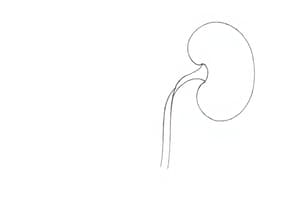Podcast
Questions and Answers
What is the primary function of the kidneys in regulating calcium levels?
What is the primary function of the kidneys in regulating calcium levels?
- Reabsorption and excretion of calcium (correct)
- Excretion of calcium
- Production of calcium
- Storage of calcium
Which hormone stimulates calcium reabsorption in the kidneys by increasing the expression of calcium transport proteins?
Which hormone stimulates calcium reabsorption in the kidneys by increasing the expression of calcium transport proteins?
- Calcitonin
- Insulin
- Parathyroid hormone (PTH) (correct)
- Vitamin D
In which segment of the nephron does the majority of calcium reabsorption occur?
In which segment of the nephron does the majority of calcium reabsorption occur?
- Thick ascending limb of Henle's loop
- Distal convoluted tubule
- Proximal convoluted tubule (PCT) (correct)
- Collecting duct
What is the primary calcium transport protein in the PCT, regulated by PTH and vitamin D?
What is the primary calcium transport protein in the PCT, regulated by PTH and vitamin D?
What is the mechanism by which the kidneys regulate calcium reabsorption in response to changes in serum calcium levels?
What is the mechanism by which the kidneys regulate calcium reabsorption in response to changes in serum calcium levels?
What is the effect of increased serum calcium levels on PTH secretion?
What is the effect of increased serum calcium levels on PTH secretion?
Flashcards are hidden until you start studying
Study Notes
Renal Calcium Reabsorption
Overview
- Kidneys play a crucial role in regulating calcium levels in the body through reabsorption and excretion
- Calcium reabsorption in the kidneys helps maintain calcium homeostasis
Mechanisms of Renal Calcium Reabsorption
- Parathyroid hormone (PTH): stimulates calcium reabsorption in the kidneys by increasing the expression of calcium transport proteins
- Vitamin D: enhances calcium reabsorption by increasing the expression of calcium-binding proteins
- Calcium-sensing receptor (CaSR): regulates calcium reabsorption by detecting changes in serum calcium levels
Sites of Calcium Reabsorption
- Proximal convoluted tubule (PCT): majority of calcium reabsorption occurs here, driven by PTH and vitamin D
- Thick ascending limb of Henle's loop: additional calcium reabsorption occurs here, regulated by CaSR
Calcium Transport Proteins
- Transient receptor potential vanilloid 5 (TRPV5): primary calcium transport protein in the PCT, regulated by PTH and vitamin D
- Calbindin-D28k: calcium-binding protein that facilitates calcium transport in the PCT
Regulation of Renal Calcium Reabsorption
- Feedback loop: increased serum calcium levels inhibit PTH secretion, reducing calcium reabsorption and promoting calcium excretion
- Hormonal regulation: PTH, vitamin D, and calcitonin regulate calcium reabsorption in response to changes in serum calcium levels
Renal Calcium Reabsorption
- Kidneys play a crucial role in regulating calcium levels in the body through reabsorption and excretion to maintain calcium homeostasis
Mechanisms of Renal Calcium Reabsorption
- Parathyroid hormone (PTH) stimulates calcium reabsorption in the kidneys by increasing the expression of calcium transport proteins
- Vitamin D enhances calcium reabsorption by increasing the expression of calcium-binding proteins
- Calcium-sensing receptor (CaSR) regulates calcium reabsorption by detecting changes in serum calcium levels
Sites of Calcium Reabsorption
- Proximal convoluted tubule (PCT) is the primary site of calcium reabsorption, driven by PTH and vitamin D
- Thick ascending limb of Henle's loop is an additional site of calcium reabsorption, regulated by CaSR
Calcium Transport Proteins
- Transient receptor potential vanilloid 5 (TRPV5) is the primary calcium transport protein in the PCT, regulated by PTH and vitamin D
- Calbindin-D28k is a calcium-binding protein that facilitates calcium transport in the PCT
Regulation of Renal Calcium Reabsorption
- Feedback loop: increased serum calcium levels inhibit PTH secretion, reducing calcium reabsorption and promoting calcium excretion
- Hormonal regulation: PTH, vitamin D, and calcitonin regulate calcium reabsorption in response to changes in serum calcium levels
Studying That Suits You
Use AI to generate personalized quizzes and flashcards to suit your learning preferences.



